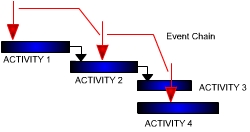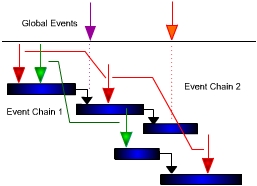Event Chains
Events can cause other events, which will create event chains. These event chains can significantly affect the course of the project. For example, requirement changes can cause an activity to be delayed. To accelerate the activity, the project manager allocates a resource is from another activity, which then leads to a missed deadline. Eventually, this can lead to the failure of the project.
Events may instantly trigger other events or transform an activity to another state. Event chains can be defined in several different ways. For example, a single event type can be defined as “Change probability of the particular risk”. In this case, one event can trigger another event. Another way to define event chains is to use an event “Start another task” or “Execute Mitigation Plan”. Event chains must by identified in the same manner (names) as single events.

Names are important for further analysis of the chains, for example for identification of critical event chains. Event Chain Diagrams are visualizations that show the relationships between events and tasks and how the events affect each other. The simplest way to represent these chains is to depict them as arrows associated with certain tasks or time intervals on the Gantt chart. Different events and event chains can be displayed using different colors. Events can be global (for all tasks in the project) and local (for a particular task). By using Event Chain Diagrams to visualize events and event chains, the modeling and analysis of risks and uncertainties can be significantly simplified.


